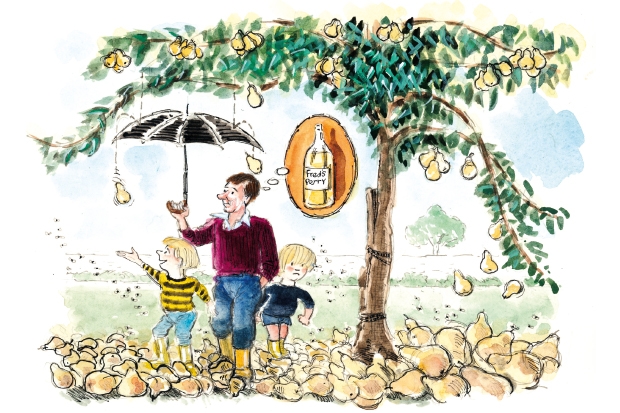When we moved into the new house, we felt lucky to have a pear tree in our garden. How grown up, we thought. Then September came and the tree started raining fruit. Masses of fruit. Our green and pleasant lawn transformed into a carpet of greeny-yellowy-brown pears, which squelched gruesomely underfoot. I invited my children and nephews to help, offering them 5p for every pear they picked up. Big mistake. The boys quickly realised they were on to a winner and I had to fork out about £25.
The worst part, though, was not knowing what to do with this unwanted harvest, which rotted quickly and attracted thousands upon thousands of fruit flies, which then began to colonise the kitchen. We ended up loading great sackfuls of the mangy fruit into the car and driving them to the dump. Yet the pears kept falling.
I told The Spectator’s Food and Drink editor Lara Prendergast about this dilemma. Lara suggested that I make perry, which is pear cider, in case you didn’t know (I didn’t). Great, I said, not thinking the idea would go much further. I mean I like drinking cider, much too much, but I had always thought home-brewing it was for mentally ill people in the West Country. Lara persisted, however, and emailed the good people at Love Brewing, who sent over a cider-making kit. Three large boxes duly appeared, containing various metal objects, mysterious powders, a bucket, a siphon, about 50 empty plastic bottles, a thermometer and something called a hydrometer. It all looked disturbingly complicated and scientific.
The large metal objects turned out to be a crusher and a presser — and they were the fun bits. You have to assemble the machines yourself, which feels artisanal in a satisfying way. With the crusher, you attach a large red wheel on one side and spin it in order to rotate the blades, which then annihilate the pears. It makes a good c-r-u-u-u-nch noise. My younger son Gus, aged three, kept trying to stick his hand into the blender when I wasn’t looking, which was a bit frightening, but I managed to avoid mangling his fingers, and turned several kilos of pears into a rather horrid-looking mass of pulp.
Following Love Brewing’s instructions, I then put the pulp into a straining bag and placed it in the presser, which is a large vertical vice designed to squeeze out all the liquid. The pear juice, which tastes quite good by itself, trickles down into a receptacle. I then added something called a Campden Tablet to stop it from oxidising. (Oxidising is not good, apparently, though I read on the internet that purists consider Campden Tablets to be cheating.)
Next came fermentation, the crucial but boring bit. This is daunting if, like me, the thought of doing anything involving science makes your brain freeze. But Love Brewing sent me some very helpful videos, presented by a delightfully earnest man called Richard Blackwell, who reminded me of my old physics teacher. Richard talks slowly and clearly so that even morons can follow. He is very strict about hygiene and orders brewers to cleanse all equipment repeatedly using the sterilising powder provided, which I did.
Richard explained that Pectolase is a useful enzyme because it breaks down the cell walls of the fruit and releases flavour. So I took out the pot marked Pectolase and put a teaspoon in the bucket. I also added teaspoons from the pots marked tannin, malic acid and nutrient, and finally put in the all-important yeast.
Then I used the hydrometer, which, I figured out by Googling, works like a sort of bobbing dipstick and measures the density of the liquid. At the start of fermentation, the cider should have an ‘original gravity’ of around 1,040. By the end it should have a ‘final gravity’ of 1,000.
Confused? I was. By sheer luck, after 13 days the hydrometer reading seemed about right, which meant that the brew had brewed. Hurrah, although the liquid gave off a disturbing stench. Gus walked over to the bucket, sniffed it with disdain, and said: ‘That smells so disgusting Dadda,’ which dented my confidence somewhat. But I carried on and set about bottling. As Love Brewing instructed, I added sugar to each plastic bottle to help the cider ferment again and make it go fizzy. I left the bottles for a few more days and started giving them out to people as presents. This was not generosity, but a means of making sure I didn’t have to drink the stuff myself.
I took a couple of bottles into work and forced my colleagues to have it with their lunches. To my surprise, they drank it without retching, though it was observed that it tasted very dry. But Katy Balls, our diary editor, said: ‘If I drank that in the pub, I don’t think I’d complain,’ which was dangerously close to a compliment. Someone else suggested I put labels on the bottles and call it Fred’s Perry. What a pleasing thought.
Encouraged by the response, I set about making another batch, this time using a pile of apples which my friend Paul brought over. This second brew is now in my kitchen, fermenting away. Perhaps the best part is that, even though I am keen to give my cider to others, I have little desire to drink it. If you think you might be an alcoholic, my advice would be to take up home-brewing.







Comments